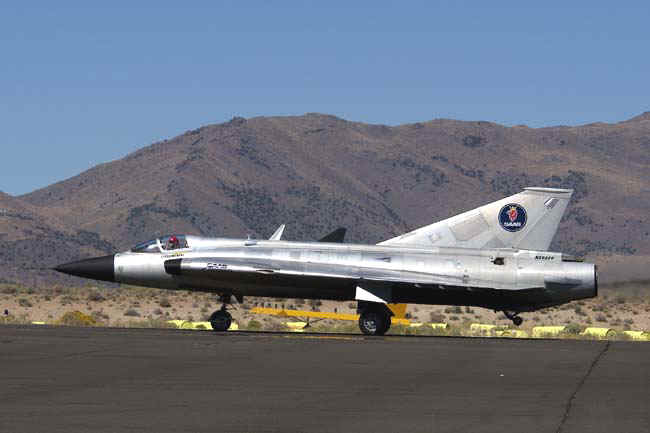|

A J35 Draken sponsored by a Saab auto dealer in
Sacramento, California taxies
for takeoff at Reno, Nevada, USA, in September, 2003.
Photo by C.F. Smith
History: In 1949, Saab
designers began work on a new supersonic, all-weather, single-seat fighter for the Swedish
air force. Designer Erik Bratt came up with a unique double delta shape that offered an
aerodynamic package along with structural stability. The double delta shape means that the
wing is comprised of two different wing sections with different sweep angles. The inner
wing, with an 80-degree angle, is optimized for high-speed performance, while the outer
wing, with a 60-degree angle, is optimized for low-speed performance. The design also
featured fully-powered controls, a combination of external and integral fuel tanks, and
retractable tricycle landing gear that was complemented by two retractable tail wheels.
This feature allowed a tail-down landing, which made good use of the aerodynamic braking
effect of the wing. The Draken is capable of short takeoffs and landings, which meant that
it could be stationed at small airfields.
The first Saab-35
prototype featured a Rolls-Royce Avon turbojet engine. It was flown on 25 October 1955,
and the J 35A Draken ("dragon") began entry into the
service in March 1960. The series-built aircraft used Volvo Flygmotor RM6B turbojets,
which were license-built versions of the Rolls-Royce engine. Saab exported the plane to
Denmark, Finland and Austria, where they were used as trainers, fighters and tactical
reconnaissance planes. Finland also manufactured the Draken for a short time: twelve
planes were built at the Valmet factory. The plane also was offered unsuccessfully to the
Swiss air force, and Venezuela and Singapore were reportedly interested in purchasing the
Draken, although no sales were made to these countries.
Major production variants included the J 35A,
the first production version; the Sk35C, a two-seat operational
trainer without combat capability; the J 35D, an improved
production version with a more powerful engine, advanced avionics and a zero-zero ejection
seat; the S 35E, a tactical reconnaissance version with five
cameras in the nose and cameras in one or both cannon bays; and the J 35F,
the final production version with more advanced avionics and equipped to carry Hughes
Falcon missiles instead of Sidewinders.
Although Sweden has replaced the Draken with the
Saab 37 Viggen, the plane remained in active service for almost 40 years after its
introduction, and it is still being used as a military aircraft in Austria. Production
ceased in 1974. The Draken, Europe’s first supersonic combat aircraft, now is used as
a high-speed test aircraft for NASA and other U.S. governmental agencies. At least one has
been flown as a privately-owned warbird, and was often seen on an American TV
advertisement for Miller beer.
Nicknames:
Dragon
Specifications (J 35F):
Engine: One 17,262-pound thrust afterburning Flygmotor RM6C turbojet (license-built
Rolls-Royce Avon 300)
Weight: Empty 16,369 lbs., Max
Takeoff 27,998 lbs.
Wing Span: 30ft. 10in.
Length: 50ft. 4.5in.
Height: 12ft. 9in.
Performance:
Maximum Speed at
36,000 ft: 1,320 mph (Mach 2)
Ceiling: 65,615
ft.
Range: ~750
miles
Armament:
One 30-mm Aden
M/55 cannon in starboard wing
Two RB 27
missiles
Two RB 28
Missiles
Up to 2,205
pounds of bombs or 12 135-mm (5.3-inch) Bofors rockets
Number Built: 606
Number Still Airworthy: Active Military:
Unknown. Civilian Operated: At least 5.
Links:
AeroGroup, Inc., Jacksonville, Florida, USA
-- Draken available for contract training, testing and movie work.
Desert Drakens at Inyokern, California
Draken Page
Draken Photos at
"Austrian Fighter Selection" SIte (in German)
Draken Team Karup
Flight Research, Inc.
Draken Page
Saab 35 Draken
History Page

[Back to Warbird Alley's Main
Page]
All text and photos Copyright 2016 The
Doublestar Group, unless otherwise noted.
You may use this page for your own, non-commercial reference purposes only.
 |